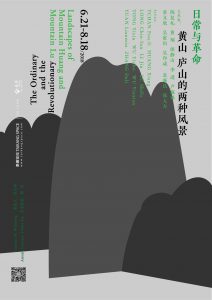Frontier: Re-assessment of Post-Globalisational Politics
Artists: Tchan Fou-li, Huang Xiang, Long Chin-San, Li Jin, LU Shifu, Tong Yi xin, Wu Yinbo, Wu Yinxian, Yuan Lianmin, Zhang Dali
Curator: Su Wenxiang
Duration:2018.6.21 – 8.18
Opening: 4:00pm, Thursday, June 21, 2018
Opening Forum: 2:00-3:30pm, March 20, 2018
Venue:Cuigezhuang, Chaoyang District, Beijing, CHINA
Taikang Space’s latest exhibition The Ordinary and the Revolutionary: Landscapes of Mountain Huang and Mountain Lu will be opened on June 21. The exhibition will continue until August 18th.
Based on the representative works of Mountain Huang and Mountain Lu taken by several important photographers in the 1960s and 1970s from Taikang’s collection, the exhibition attempts to conduct archaeological and iconographic analysis of the origins of Chinese landscape photography originated in that particular era, and of the typical modes of landscape photography rooted in the dissemination of traditional aesthetics, and further explores the contextual encounters of typical works both coerced by the revolutionary discourse and within the daily expression of general landscape photography.
Mountain Lu Scenic Area was once the hometown of young artist Tong Yixin, who is now living in New York. He once collected and appropriated the Mountain Lu landscape photos from his WeChat Moments to make a book entitled “Hometown Landscape” in hundreds of pages. When completed, the local authorities demanded the indigenous people to move away from the scenic spot. The author’s behavior could have slightly eased the homesickness, yet in the end, it increased the division and became a text of accusation and commemoration. Through the works of the two artists within the same dual contexts of contemporary art and photography, the exhibition seeks to bring the history-based narrative back to the present, thereby making the details and nuances in the discussion, as well as its abstract geographical concepts involved in the exhibition more tangible and concrete.

